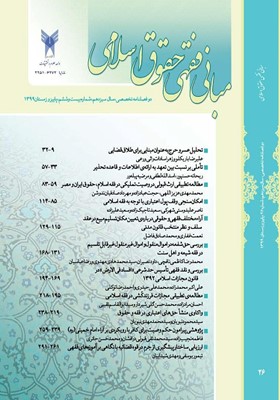ساحتهای اجتماعی در مکتب فقهی حله
محورهای موضوعی : فقه السیاسة و الحکومةمحبوبه حسینی 1 * , عذرا انتخابیان 2 , محسن رزمی 3
1 - گروه فقه و مبانی حقوق اسلامی، واحد مشهد، دانشگاه آزاد اسلامی، مشهد ایران.
2 - استاد و عضو هیئت علمی گروه فقه و مبانی حقوق اسلامی، واحد مشهد، دانشگاه آزاد اسلامی، مشهد ایران.
3 - دانشکده الهیات و معارف اسلامی، دانشگاه آزاد اسلامی، مشهد، ایران
کلید واژه: تاریخ فقه, مکتب فقهی حله, فقه الاجتماع, عقلگرایی استدلالی, مناسبات اجتماعی فقه, فقه حکومتی, علامه حلی,
چکیده مقاله :
ساحات اجتماعی یک مکتب در یک برهه تاریخی چگونه ترسیم میشود و فقها چه نقشی میتوانند در این ساحات ایفا کنند؟ این تحقیق برای رسیدن به پاسخ این مسأله، در الگوی مکتب فقهی حله، با رویکرد توصیفی تحلیلی، گزارش های تاریخی و گزارههای فقهی و اصولی را بررسی میکند. این جستار ابتدا پدیدههای اجتماعی که در برابر فقهای مکتب حله قرار داشت را ترسیم میکند؛ پدیدههایی نظیر جنگ مغول، قیامهای مردمی علیه مغول، منجیگرایی، قبیلهگرایی، تکثر ادیان و مذاهب، موقعیت جغرافیای سیاسی و اقتصادی حله و پیشینه جایگاه اجتماعی فقهای حله. سپس آثار و فعالیتهای علمی و عملی فقهای حله در ساحت اجتماعی را با عنایت به این فضا رصد مینماید. حاصل این رصد، استنتاج چهار ساحت معنویت، آموزش، عقلگرایی استدلالی و تعامل اجتماعی و انحاء و انواع آنها است. در تحلیل نهایی بیان میشود که فقها با توجه به مبانی شریعت و اصول اعتقادی، توفیق اصلاح و ارشاد اجتماعی را یافتند به گونهای که نسبت به بسیاری از دستاوردهای حکومتی و اجتماعی رقیب، اصولیتر و گستردهتر بود. این توفیق، توفیق مضاعف و متقابل دیگری به همراه داشت و آن پویایی و توسعه فروع فقه، اصول فقه و مبانی کلامی فقه شیعه است.
How are the social aspects of a school depicted at a historical juncture, and what role can jurists play in these aspects? In order to reach the answer to this question, in the model of juridical school of Hillah, with a descriptive-analytical approach, it examines historical reports and jurisprudential and principled propositions. This essay first depicts the social phenomena that stood in front of the jurists of the Hillah school; Phenomena such as the Mongol War, popular uprisings against the Mongols, saviorism, tribalism, the multiplicity of religions and sects, the political and economic geographical location of Hillah, and the background of the social status of the Hillah jurists. Then he observes the scientific and practical works and activities of the jurists of Hillah in the social aspects with regard to this space. The result of this observation is the inference of the four aspects of "spirituality", "education", "reasoning rationalism" and "social interaction" and their types and varieties. In the final analysis, it is stated that the jurists, according to the principles of Sharia and doctrinal principles, succeeded in reforming and social guidance in a way that was more principled and broader than many rival governmental and social achievements. This success brought with it another double and reciprocal success, and that is the dynamism and development of the branches of jurisprudence, the principles of jurisprudence and the theological(kalam) foundations of Shia jurisprudence.
_||_

